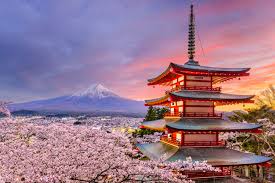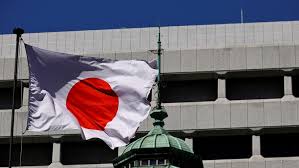Japan: The country, which consists of four main islands—Honshu,
Hokkaido, Kyushu, and Shikoku—along with thousands of smaller islands, has a population of over 125 million people. Japan’s influence on the world extends far beyond its geographical borders, touching various aspects of global culture, economics, and technology.
Table of Contents
Japan: Geography and Natural Beauty

Japan’s geography is characterized by its mountainous terrain, active volcanoes, and extensive coastline. About 70% of Japan’s land is mountainous,
with Mount Fuji, an iconic symbol of the country, standing as its highest peak at 3,776 meters (12,389 feet). The country is situated along the Pacific Ring of Fire, which makes it prone to earthquakes and volcanic eruptions. Despite these natural challenges, Japan’s
landscapes are breathtaking, with lush forests, serene lakes,
and picturesque rural areas that have inspired countless works of art and literature.
The country’s varied climate—ranging from the subtropical south to the temperate north—
allows for a diversity of flora and fauna. Japan’s natural beauty is celebrated in its many national parks and UNESCO World Heritage sites
, including the famous cherry blossoms (sakura) in spring, which attract millions of visitors each year. The country’s seasons are marked by various festivals and
cultural practices, such as hanami (cherry blossom viewing) in spring and momijigari (autumn leaf viewing) in fall.
History

Japan: history is long and complex, spanning thousands of years. The earliest human settlements in Japan: date back to the Paleolithic period
, but it was during the Jomon period (14,000–300 BCE) that the first distinct culture emerged. The following Yayoi period (300 BCE–300 CE)
saw the introduction of rice farming, metalworking, and the rise of a more structured society.
The Yamato period (300–710 CE) marked the beginning of the
Japanese imperial system, which continues to this day, making it the oldest continuous hereditary monarchy in the world. Buddhism was introduced from Korea and China during this period, profoundly influencing Japanese culture, art, and architecture.
Japan’s medieval era, known as the Kamakura and Muromachi periods, saw the rise of the
samurai warrior class and the establishment of a feudal system. The country was unified in the late 16th century by powerful warlords like Oda Nobunaga,
Toyotomi Hideyoshi, and Tokugawa Ieyasu, who founded the Tokugawa shogunate, a military government that ruled Japan from 1603 to 1868. This era, known as the Edo period, was marked by peace,
economic growth, and isolation from the rest of the world.
Japan: isolation ended in 1853 when Commodore Matthew Perry of the United States
forced the country to open its ports to Western trade. This led to the Meiji Restoration of 1868, during which the emperor was restored to power,
and Japan rapidly modernized, adopting Western technologies and systems. By the early 20th century, Japan had become a major industrial and military power, expanding its territory across Asia.

Japan: participation in World War II ended in defeat after
the United States dropped atomic bombs on Hiroshima and Nagasaki in 1945. The post-war period saw Japan’s rapid recovery and transformation into an economic powerhouse.
Culture
Japanese culture is a fascinating blend of traditional and modern elements. On one hand, Japan: is deeply rooted in its ancient customs and traditions, such as tea ceremonies,
kabuki theater, and sumo wrestling. Shinto, the indigenous spirituality of Japan, and Buddhism play significant roles in Japanese life,
influencing everything from art and architecture to daily rituals.
Traditional Japanese arts, such as calligraphy (shodo), flower arranging (ikebana), and origami, are still practiced widely. The country’s literature, dating back to the Tale of Genji—often considered the world’s first novel
—reflects its rich cultural heritage. Similarly, Japanese cuisine, known for its emphasis on fresh ingredients and aesthetic presentation
, is an integral part of the culture, with sushi, tempura, and ramen gaining international popularity.
On the other hand, Japan is also at the forefront of modern pop culture. The country is the birthplace of anime, manga, and video games, which have garnered massive global followings. Japanese fashion, particularly from districts like Harajuku in Tokyo, is known for its bold, eclectic styles. Japan’s technological advancements, from robotics to consumer electronics, have also left a significant mark on the world.
Economy and Technology
Japan: is one of the world’s leading economies, known for its advanced technology, high-quality manufacturing, and strong work ethic. The country’s economic model, often referred to as the
“Japanese Miracle,” saw it rapidly industrialize and grow in the decades following World War II. Major Japanese companies, such as Toyota, Sony, Panasonic, and Nintendo, have become global brands synonymous with innovation and quality.
Despite its economic strengths, Japan faces significant challenges, including an aging population, a declining birth rate, and the need
to adapt to a changing global economy. The government and businesses are increasingly focusing on automation, innovation, and sustainability to address these issues.
Society and Modern Issues
Japanese society is known for its emphasis on harmony, respect, and group cohesion,
values deeply rooted in its Confucian and Buddhist traditions. The country has one of the lowest crime rates in the world and
is known for its cleanliness, efficiency, and politeness.
Gender roles and equality are also evolving in Japan, with increasing awareness and efforts to address gender
disparities in the workplace and society. Mental health issues, particularly among young people, have also become a growing concern, highlighting
the pressures of Japan’s highly competitive education and work environments.
indianfastearning.comJapan Ends ‘Megaquake’ Advisory After No Abnormalities Observed 2024 wonderful
Conclusion
Japan: is a nation where tradition and modernity coexist in a delicate balance. Its history is marked by resilience and adaptability,
and its culture is a rich tapestry of ancient customs and contemporary innovation. As Japan continues to navigate the challenges of the 21st century,
it remains a vital player on the global stage, influencing everything from technology and economics to culture and art. The country’s unique blend of old and new continues to captivate the world, making Japan a truly remarkable nation.
www.youtube.comhttp://Japan







